Prop Vessel Monitoring System (PropVMS)
Llike many boaters I have to keep my boat some distance from my home. Reading through the forums there seems to be several people interested in projects like this so I thought I would make mine available.
It is a work in progress in many of the planned features are not working yet. I'm using a propeller demo board and the Spark fun GM 862 GPS breakout module .The code is based on bits and pieces that I pulled out of programming and customizing the multicore propeller book which I found extremely useful. Currently the system has three inputs, one for a float switch for high water alarm, one for a window comparator for battery voltage alarm and one for door and hatch switches. The system is currently set up to place a phone call and send an SMS message indicating the alarm condition. One thing about SMS messages there is no quality of service requirements for them so it can be several minutes or hours before they're delivered to the recipient so the device will also place a call to whatever number you want so you will get a call and an SMS message following to let you know the condition. Because of an error on the GSM breakout board the GPS antenna does not fit so the GPS data has not been integrated into the system yet.
The system will also have an Xbee and Bluetooth interface. I plan to use the Xbee to control remote relays for bilge pumps, lights and eventually the ability to remotely control and monitor the HVAC systems and environmental conditions temperature/humidity via SMS messages. The Bluetooth will be used for local control via a smart phone.
I thought about using one of my ham radios HT's and could easily made the hop between my boat and home but I'm not always home and I don't always have my handy talkie (HT) with me, But my cell phone is always with me
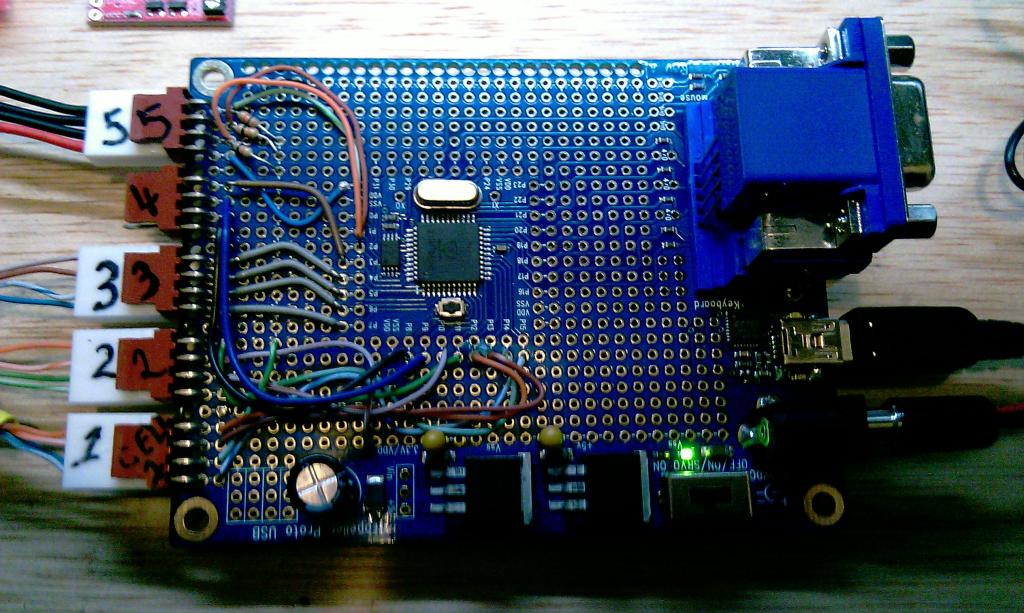
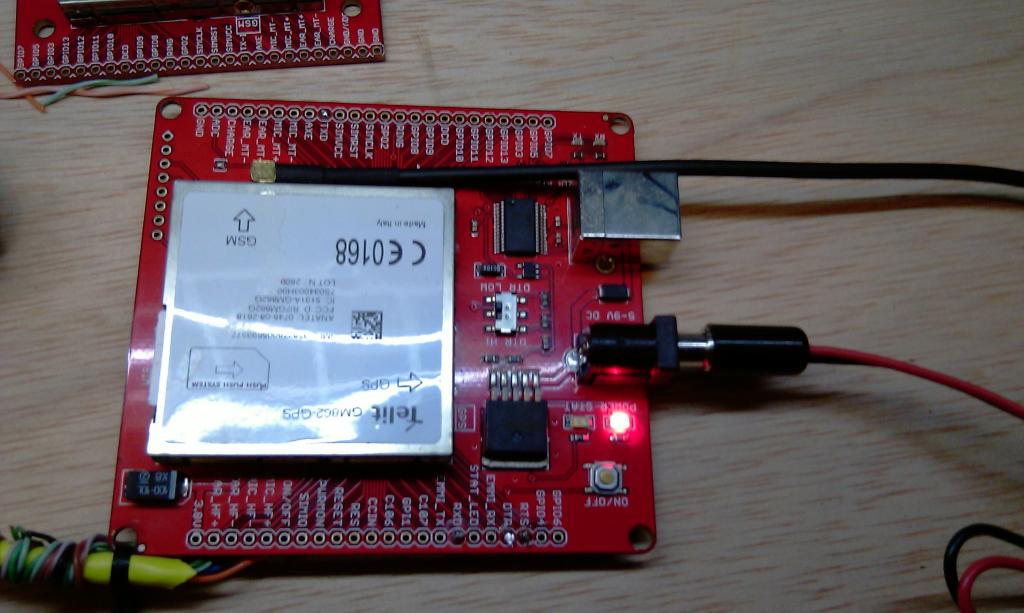
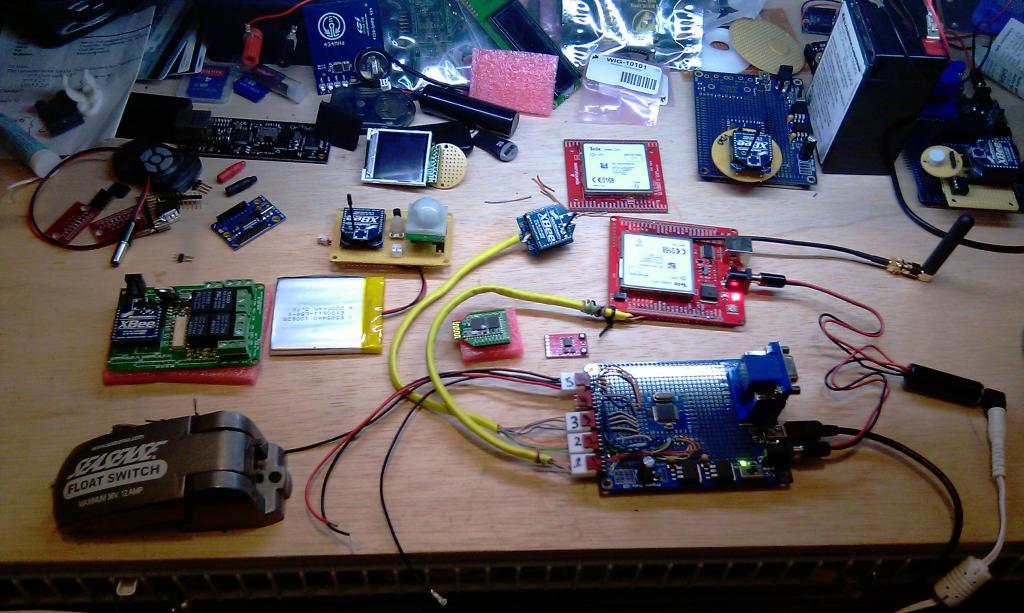
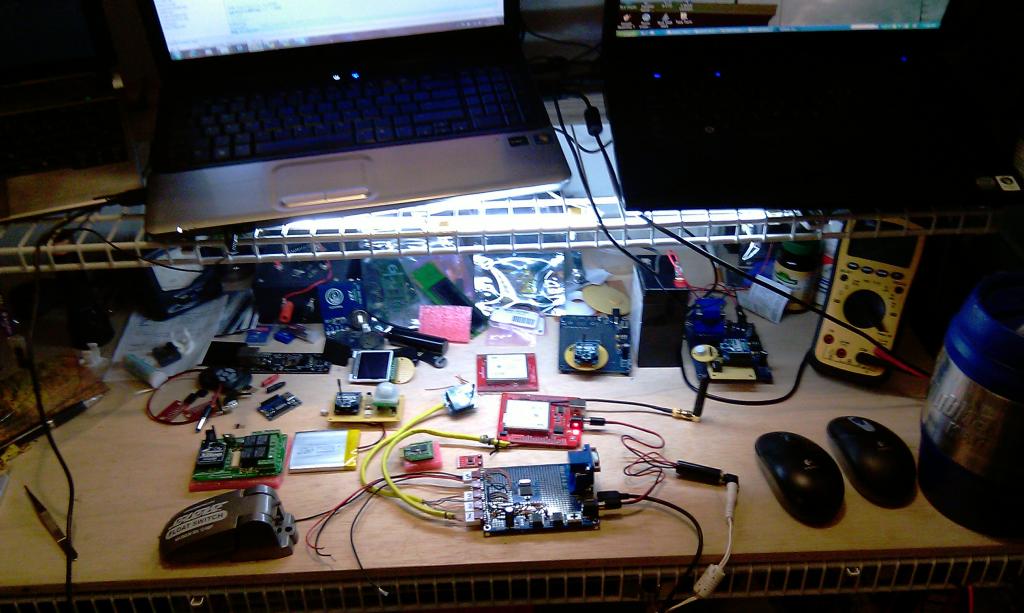
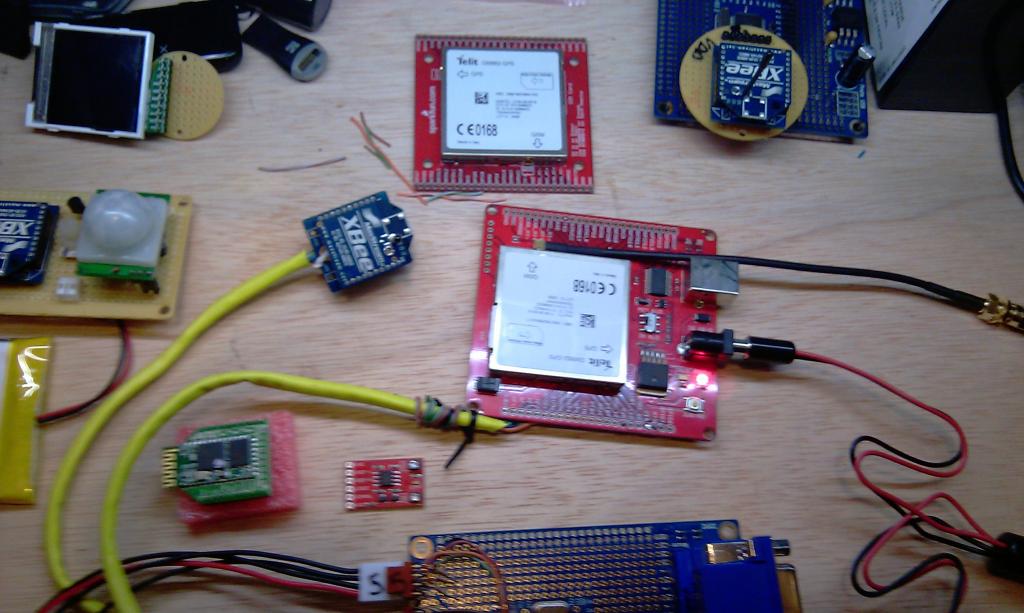 PropVMS.spin
PropVMS.spin
It is a work in progress in many of the planned features are not working yet. I'm using a propeller demo board and the Spark fun GM 862 GPS breakout module .The code is based on bits and pieces that I pulled out of programming and customizing the multicore propeller book which I found extremely useful. Currently the system has three inputs, one for a float switch for high water alarm, one for a window comparator for battery voltage alarm and one for door and hatch switches. The system is currently set up to place a phone call and send an SMS message indicating the alarm condition. One thing about SMS messages there is no quality of service requirements for them so it can be several minutes or hours before they're delivered to the recipient so the device will also place a call to whatever number you want so you will get a call and an SMS message following to let you know the condition. Because of an error on the GSM breakout board the GPS antenna does not fit so the GPS data has not been integrated into the system yet.
The system will also have an Xbee and Bluetooth interface. I plan to use the Xbee to control remote relays for bilge pumps, lights and eventually the ability to remotely control and monitor the HVAC systems and environmental conditions temperature/humidity via SMS messages. The Bluetooth will be used for local control via a smart phone.
I thought about using one of my ham radios HT's and could easily made the hop between my boat and home but I'm not always home and I don't always have my handy talkie (HT) with me, But my cell phone is always with me








Comments
I have an IR sensor which I bought for ~$30. It has batteries and a keypad all in one. I plan to hack this. Obviously it will take me some time - other things on but I want to ultimately include video or still pics so I can see what is happening if necessary. I think the mobile network is the best (via internet) because I always have my mobile phone with me.
Perhaps the ZipIt2 could come in handy here too because it has WiFi and a serial port (needs to be wired by hand) and runs a version of linux.
I wonder if using the tilt sensor if you can tell the difference between somebody stepping on the boat or the wind just causing it to rock back and forth you would probably need a gyro to to be of the measure the rate of change but that would be an interesting use.
The tilt sensor could probably differentiate a person from the waves most of the time in that pattern (rate & extent) of roll changes abruptly and the boat lists toward the dock temporarily and roll is interupted. A person can detect that even on our 82' steel cutter in relatively calm conditions so a sensor should be able to do the trick on a more tender vessel. A similar pattern would be set off by tall waves pulling the lines taught against the cleats which is another situation you might want to know about. Another sensor I had looked at but not explored is attaching a strain gauge or flex sensor to a snubber on the line to sense the relative pull/slack of the lines to identify stress from the wind. Another way to get at the stress on the lines is to calculate the sail pressure on the hull and superstructure based upon the wind speed and direction.
Kevin, the main Wii controller is an I2C master and apparently will not transmit it's info down the I2C pipe (according to the hack websites anyway). However, it may be possible to chat to it via WiFi (IIRC that's what it uses for comms to the main unit).
I am wanting the pcbs for my QuadCopter design and my RepRap design, plus some others. Of course, my QuadCopter is the beginning of an autopilot for my boat (to backup "George", my trusty Navman autopilot).
Have you looked at the Black & Decker reflow oven(infraWave) I picked one up online for under 100. I haven't had a chance to run any boards through it yet but it rocks on frozen egg rolls lol
Your quadcopped board would be perfect for this hybrid lighter-than-air/heavier-than-air winged blimp project I have been messing with. The thing is 15 feet long and should have a net lifting capacity of over 5 pounds. The pictures I have are not real clear but basically it starts with a rigid frame made from carbon fiber spars covered in rip stop nylon with a zero pressure bladder and high pressure bladder inside use for buoyancy control. For the first attempt at it and making patterns and doing the sewing myself it did not come out too bad but has a bit of a twist to it. I need to lay out a 3-D model so I can convert it to flat panels and have a cad cut and sewn in a sail loft....... somebody they can sewe with precision
From what I understand, the sail lofts glue the seam with double sided tape before before they sew it. No such luxuries when I used to make my sails when I was a teenager (a long time ago). I did however, cut my material using a soldering iron, which had the advantage of selving (sealing) the edges. Electronics and computers got in the way of my sailing
I love your idea. I am doing a monitoring system on a ship that I am helping to restore and is the USS Zuni/USCG Cutter Tamaora. The Tamaora was the one that did the real rescue in The Perfect Storm, that the book/film was based on. Are system was going to use OPTO22 brain board and 24 I/O board that monitors the fire alarm, bilge alarm and the 460VAC/3PH incominng shore power connection.
We were looking for a cheep way to talk to the OPTO22 brain board and your idea maybe the ticket for us. Are you paying extra on your cell phone service and which gsm modem are you using?
Are you connected to shore power? If you are, I would monitor the shore power for power loss. This will let you know two things
1) Your lines may have broken and your sail boat foating away without you.
2) You are on the backup or house battery.
The idea of using a tilt sensor is a great idea and it gives me the idea to put one on our ship. But, I would mount it low and on the centerline of your sail boat.
I'm using a Tellit GM-862 -- GPS And a Spark fun breakout board. it is a GSM module and will only work with AT&T and T-Mobile there might be some other small carrier
it works with but I'm not aware of. You will also need a SIM card that goes into the module. I am using T-Mobile prepaid account for access to the device all the prepaid accounts that I looked at have a parasitic charge that depletes the account even though the phone is not being used. With T-Mobile if you purchase $100 or more the minutes will not expire for 12 months. So basically I pay $100 per year for service that will give you 1000 minutes or about 400 SMS messages at $.25 apiece in or out. The easiest way to get a sim card is to purchase one of the cheap prepaid phones I paid $10 for the one I use.
keep the phone, user to activate the account and to recharge the account
I'm using 2 6ah 6v sealed lead acid batteries with a small array of 9 V solar panels so it is completely separate from all other ship systems. I monitor the 12 V system but currently not monitoring the AC power. Hopefully the GPS will let me know if the boat starts to drift away. I plan to set it up with guards zones so if it drifts it will phone home.
on your power monitoring make sure your monitor all three legs, I've had one leg drop out on me before and caused some problems
Kevin
Also a digital compass could tell if the boat is loose or drifting.
Bean
Bean: A digital compass will not tell if my boat is loose or drifting as I have it anchored outside the house and tied to shore. However, it moves considerably with wind and tide - unfortunately the bad winds are onshore from S and the W.
A GPS would be the best choice. I have one of the older modules from Parallax. They are cheap. The guard band would need to be set properly for my boat as I would want a shore line barrier so I guess what I would require is a sector of a circle (i.e. a piece of a pie chart). This would not be too difficult to set up. Just plot the anchor position, the chain let out (plus the distance the GPS is from the bow), then minimum depth (low tide), and the arc (in degrees) and the direction of the centre of the arc. Now all could be quite simply calculated, with a small variance for GPS error. If the boat is not in the arc then something is wrong - Phone Home ET !
I included it with the first post it is PropVMS.spin
you may have to fuss with it a bit. You can see some of the other commands that I've commented out in the gsminit once I had the module configured I was able to reduce the commands to only a couple everything worked fine even with roaming. But if you turn the unit off and move to new location i.e. out-of-state it would not automatically reconnect when you powered it back up. The current configuration will it take longer to boot and initiate the GSM but I've tested it off and on moving to different locations in the country and it connects every time.
really haven't added any debug code because I was using a logic Prob to monitor the interface between the prop and GSM I had some problems originally with it but it came down to simply adding some delays between commands to allow for the replies from the module things happen slower than you would expect them to, is the reason for the large delays but really is comparable to when you power up your mobile phone I guess I'm just used to the prop doing everything so fast LOL
GSM.str(String("AT+BND=1", cr)) 'set to north america you will need to change BND=3 for down under I think
Oh, I was thinking it was tied to a dock.
Bean
I will be looking into the GSM Module for our ship.
normally ships requiring 460v 3 phase power have a central power distribution center were voltage and current are measured this is typically where you would want to attach the remote monitoring system. But if the vessel is very old it may not be equipped so it comes down to a couple choices current Transformers are shunts. I personally prefer current Transformers, but it's like anything I really don't know what you have so it is hard to say. On the low-tech side I've used simple power cubes that output a simple voltage 3v 5v 6v 9v dc or ac you just have to make sure you get a transformer on each leg 460v 3phase consists of three hot leads each at 220 V that can be used directly for big electric motors or run through transformers to bring it down to 110v even if it's not many power cubes are designed to operate at 220 V for sale in Europe they make it quite simple and effective interface for measuring/monitoring line voltage
I am actually at anchor but with 2 stern lines to shore as well. But after Xmas I will have to move to a mooring and here is where I really see the danger of vandals or theft. When I was on the dock it was safe because of security patrols. My neighbour lived on his boat with a dog so it was extremely safe, and we were living on it too most of the time.
My 240Vac inverter is off when I am ashore as it takes 1A+ just to idle unless absolutely nothing is on. I have 510AH of 12V AGM batteries for the house. I use an 2M approved LED anchor light.
In Australia, we do not have roaming as such. So, Telstra has the best coverage over the whole country. IIRC it is over 95% of all the population. So the roaming is not a problem here. One bill covers the whole country
The problem I was having had to do more with tower Association. When the unit is on in your moving it automatically passes tower IDs as you move. With the power off moving to a new location i.e. new tower, same provider,when you power the device up it wants to reconnect to its last known association and was not picking up the new tower ID the current configuration solves that.
I was thinking about how to set up the guard zone, it really is quite simple, rather than trying to figure out all kinds of angles. Way too difficult for me..... a guard zone is nothing more than a distance calculation from a constant. if you break it down there is really only two two basic ways to secure a boat. You have a single point mooring such as anchor or mooring ball. Or you have a multipoint mooring two anchors, a 3 anchor configuration like your boat, 4 or more anchor is the dock. The only difference between the two types is where you mark waypoint zero your center of rotation. In a single point mooring would ideally want the antenna receiver directly over the spot you drop the anchor which would make your guard zone equal your scope plus a little fudge room or just measure the distance as your backing down on the anchor. in a multipoint mooring the boat becomes the center of rotation not the anchor spot. If you turn on your chart plotter and let it run for a day or two it will draw nice pretty circles on the screen for you. So ideally waypoint 0 /center rotation would be set with the boat all tied up, with no wind waves her current. So regardless of how you tie up your boat or guard zone consolation never has to be more complex than the distance to waypoint zero.the only difference becomes where you mark waypoint zero.
The switchboard that we have is around 1980's vintage. I can give you the exact date of the switchboard when I go back to the ship later this month if you want. I hope this gives you idea what I have on our ship.
Prophead100,
What is the name for your smaller cutter (point class) and when did serve in the USGC?
Happy Holidays to you all.
Our point class cutter is the 82' Point Weber, named after its current location. ( http://www.pointweber.org/documents/ourship.htm) It was built in 1962 for Coast Guard and transferred to the Navy as a workboat retrieving missles off the coast of southern California until the 90's when it was surplused to the SeaScouts. A nice bonus is a crane on the back.
I saw your group's website and it's a cool boat and was surprised what was on the inside.
I also pm you with some questions and give our website, which is this WWW. Zunitamaora.org and about the monitoring that your wanting to do.